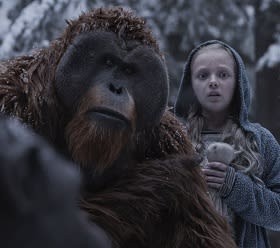War for the Planet of the Apes pushed mo-cap filming
Sci-fi follow-up War for the Planet of the Apes advanced the film industry’s use of performance capture and motion capture technology (or mo-cap) for use on location.
By Nick Goundry 12 Jul 2017

Sci-fi follow-up War for the Planet of the Apes advanced the film industry’s use of performance capture and motion capture technology (or mo-cap) for use on location.
The movie is the third entry in the rebooted Planet of the Apes franchise and features actor and filmmaker Andy Serkis as ape leader Caesar.
Vancouver was used as a base to tell the story of escalating conflict between people and intelligent apes in a near-future dystopia.
As with the previous films, War for the Planet of the Apes is set in a post-apocalyptic California, but the movie used British Columbia as a stand-in for the US west coast.
The performance capture technology used to render the apes themselves is a stand-out feature of the new franchise.
Serkis and his fellow actors who were playing ape characters performed their respective roles in performance capture bodysuits. The suits were fitted with head-mounted cameras while the actors wore dots across their bodies and faces as reference points for the digital make-up that would be added in post-production.
The technical team was tasked with making the technology work in extreme weather conditions.
“We had to take a process already considered very sensitive and carefully calibrate it into areas with sub-freezing temperatures and snow flurries,” says Dan Lemmon, visual effects supervisor for New Zealand-based Weta Digital.
“It’s exciting because we’ve opened up the possibility that you can use performance capture anywhere, interacting with any environment and still have full confidence that you’ve captured every nuance an actor is bringing.”

The performance capture process also involved 3D-scanning every facet of the film’s sets, which were built at Vancouver’s Mammoth Studios and on location in other parts of the city.
Final decisions were only made later in the production process as to what would be left physical and what would be digitally enhanced in the movie’s final cut.
“It was a monumental effort,” says Ryan Stafford, a co-producer and VFX producer on the film. “We had to shoot every shot twice – sometimes four times – then try to fit all of those complexities into a standard shooting day.”
The Apes production team also used emerging digital tools to create forest vegetation, improve the look of the ape characters’ fur and how it interacts with extreme weather, and to develop the way in which the apes could be lit on location.
James Cameron is set to continue evolving the use of performance capture in his Avatar sequels. They are scheduled to start filming in the coming months, eight years after the first movie became the most successful of all time.
For more on filming in British Columbia see our production guide.
Images: 20th Century Fox
Vancouver was used as a base to tell the story of escalating conflict between people and intelligent apes in a near-future dystopia.
As with the previous films, War for the Planet of the Apes is set in a post-apocalyptic California, but the movie used British Columbia as a stand-in for the US west coast.
The performance capture technology used to render the apes themselves is a stand-out feature of the new franchise.
Serkis and his fellow actors who were playing ape characters performed their respective roles in performance capture bodysuits. The suits were fitted with head-mounted cameras while the actors wore dots across their bodies and faces as reference points for the digital make-up that would be added in post-production.
The technical team was tasked with making the technology work in extreme weather conditions.
“We had to take a process already considered very sensitive and carefully calibrate it into areas with sub-freezing temperatures and snow flurries,” says Dan Lemmon, visual effects supervisor for New Zealand-based Weta Digital.
“It’s exciting because we’ve opened up the possibility that you can use performance capture anywhere, interacting with any environment and still have full confidence that you’ve captured every nuance an actor is bringing.”

The performance capture process also involved 3D-scanning every facet of the film’s sets, which were built at Vancouver’s Mammoth Studios and on location in other parts of the city.
Final decisions were only made later in the production process as to what would be left physical and what would be digitally enhanced in the movie’s final cut.
“It was a monumental effort,” says Ryan Stafford, a co-producer and VFX producer on the film. “We had to shoot every shot twice – sometimes four times – then try to fit all of those complexities into a standard shooting day.”
The Apes production team also used emerging digital tools to create forest vegetation, improve the look of the ape characters’ fur and how it interacts with extreme weather, and to develop the way in which the apes could be lit on location.
James Cameron is set to continue evolving the use of performance capture in his Avatar sequels. They are scheduled to start filming in the coming months, eight years after the first movie became the most successful of all time.
For more on filming in British Columbia see our production guide.
Images: 20th Century Fox
Latest news & features
Featured profiles
Promote your services with KFTV
Choose from three profile types - Basic, Silver and Gold
Create ProfileWe offer a range of display advertising opportunities.
Learn More